


Upon entering the church, one is immediately impressed by the tall vertical space. We arrived early and for a few moments were almost the only ones inside, adding further to the quiet feel of this columnar sanctuary, a little like the John Muir redwood forest in Northern California.
The vertical lines emphasize the length (about 150 yards) of the church and one can see all the way to Marc Chagall's blue windows placed at the far east end in 1974. (We'll talk windows a little later):

The sides of the nave are quite graceful with their tall columns forming graceful arches. At the very top (hard to see in the picture below) is a small rose window above two vertical windows, one of many Gothic innovations:

Allocating such a large amount of window space in a wall still strong enough to hold up the roof was not easy for Gothic architects who worked somewhat on a trial-by-error approach rather than through the application of science. Some of the cathedrals built around this time were still falling down. On the contrary, Reims' walls withstood fires and German shelling in WWI.
Turning around, the view of the center rose window looks like this:


The inside of the west (front) façade contains another Gothic decorative innovation with nine windows with coronation themes separating two rose windows. The late 13th century great rose window is shown above, dedicated to Mary who sleeps at its center surrounded by Apostles, angels, and all the usual suspects.
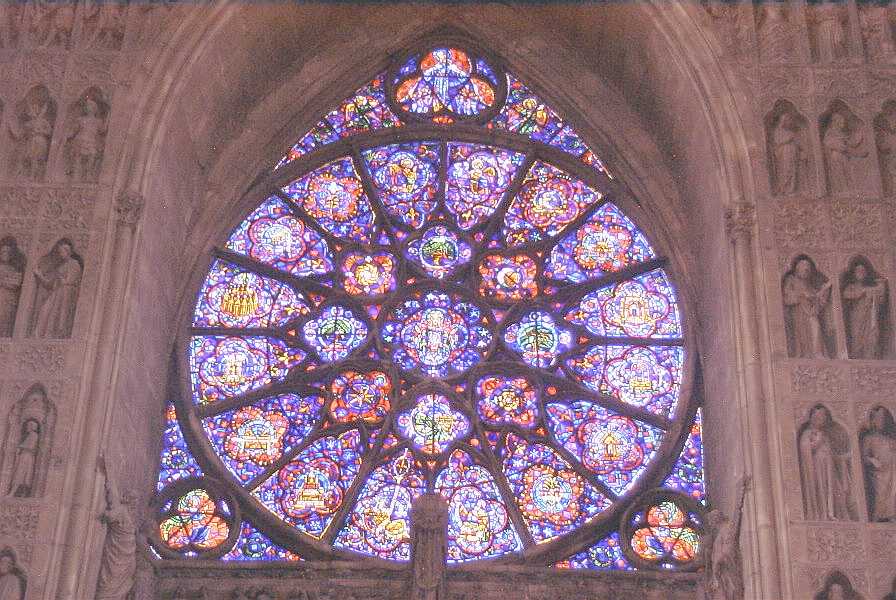
Around the lower rose window shown above (another filled pretty much with Mary icons) are 52 statues.

Here's a close-up of the some of these statues around the center door. These are on the right side depicting the life of John the Baptist. The other side honors Mary (this is the Cathedral of Notre Dame, after all):

The windows of Reims are a mixed bag, having suffered much during the ages through accident, WWI, or in some cases, the changing styles of the 18th century. Some are quite new (1930 through present) as artisan families continue to repair and replace the damaged windows. Many of the older windows are thematically linked to the function of the cathedral. For instance, they depict coronation events or define spaces used by the bishops when they met with their archbishop, the bishop of Reims. In some cases, the cathedral windows were designed with clear glass to allow more light into the sanctuary.
Compared to its model, Chartres Cathedral, where aged stain glass filters out more light each century, Reims Cathedral is quite well lit as many of the windows have been damaged and been replaced with newer stain glass or just plain glass windows. The picture below gives some idea of the difference in light admitted from clear vs. stained glass:
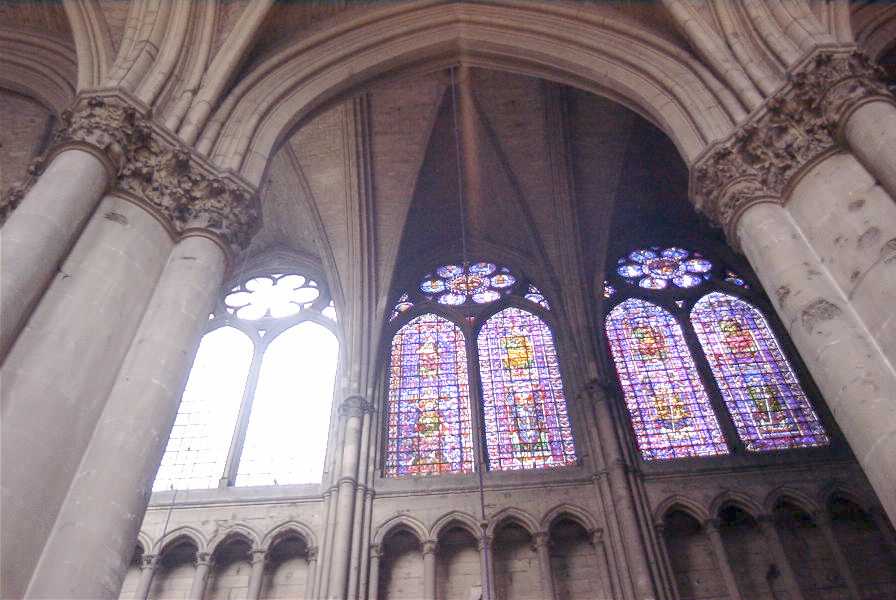
Also note the high columns which define the central nave. Here's another view showing the vaulted ceiling between stained and clear glass:
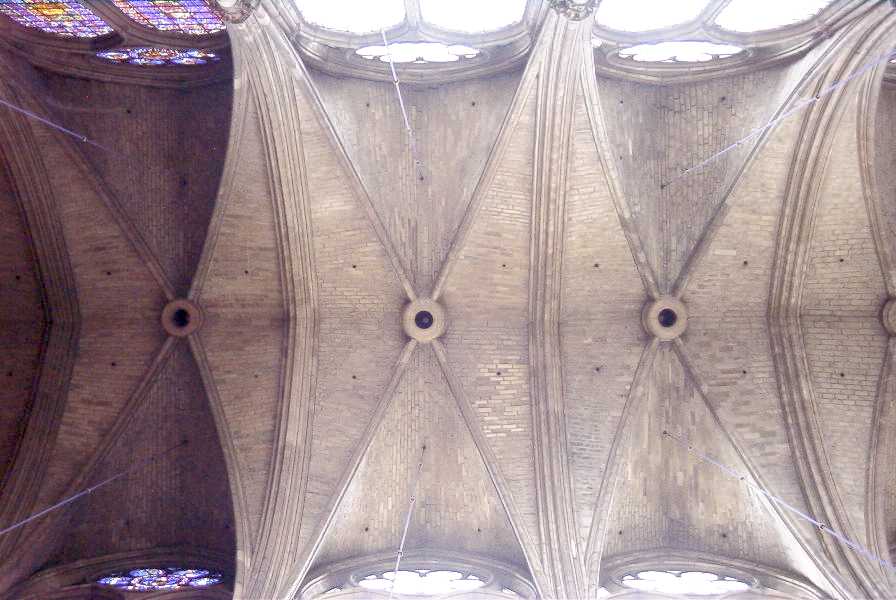
Here's a view of the South transept lower windows that one encounters on the way past the altar:
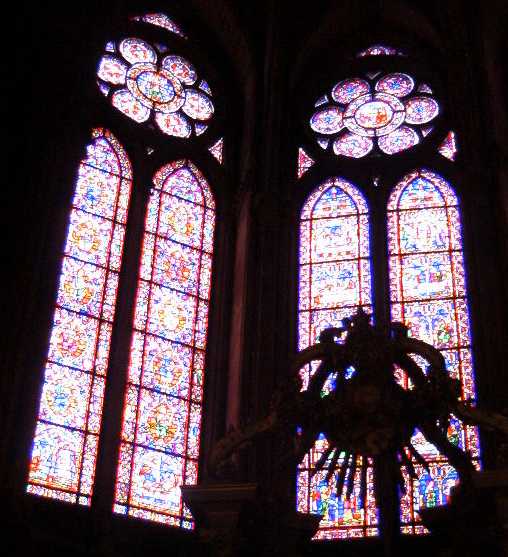
Above them are more stain glass including the south transept rose window:

The highest windows here were always meant to have clear glass to illuminate this area of the church.
Some of the stained glass is quite new from just after WWI when a local artist named Jacques Simon was able to reconstruct some of the many windows based upon drawings made by his ancestors. Simon's family has been restoring these windows for generations. The stain glass tradition remains strong even in this century and Georges Braque and Marc Chagall are only two of the better known modern artists who have worked in them.
But the most famous new windows, of course, are those made in Simon's studio by Chagall in 1974 (10 years after he painted the ceiling in our neighborhood Opera House.) Chagall was a Russian Jew who came to Paris at age 23 and flipped-flopped around Europe during revolutions, Nazi takeovers, etc.

These windows show the tree of Jesse, Christ's death and resurrection, and the baptism of Clovis. Not a bad Christian representation by an 87 year old Jew who had been exiled from both Russian and Germany in his long life! The blues were created by resurrecting medieval techniques.
In front of the Chagall chapel is the plaque explaining the site in several languages. These signs are found throughout the cathedral and are quite helpful. In this case, the description of the Christian symbols is inaccurate (Jesus is an Old Testament figure, etc.)
Beyond glass there is magnificent stone which creates a magnificent effect through its rhythmic repetition.
There are three naves, each with their strong vertical orientation culminating in a majestic window. Here's the view of the smaller northern nave looking all the way to the far window:
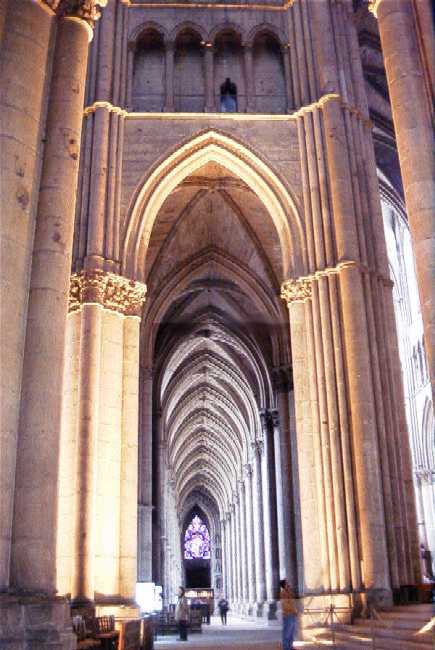
On the way up the aisle, one goes by a poorly lit chapel dedicated to Joan of Arc, an organ with 6800 pipes and 97 stops, and a 15th century clock which rings the hour and displays an automated procession. None of these pictures came out.
After lunch, we visited the treasures in the 15th century Bishop's palace but only took two pictures so for sure you have the kind of time to join us by clicking here.
Where do you want to go today? Here's a few choices:
